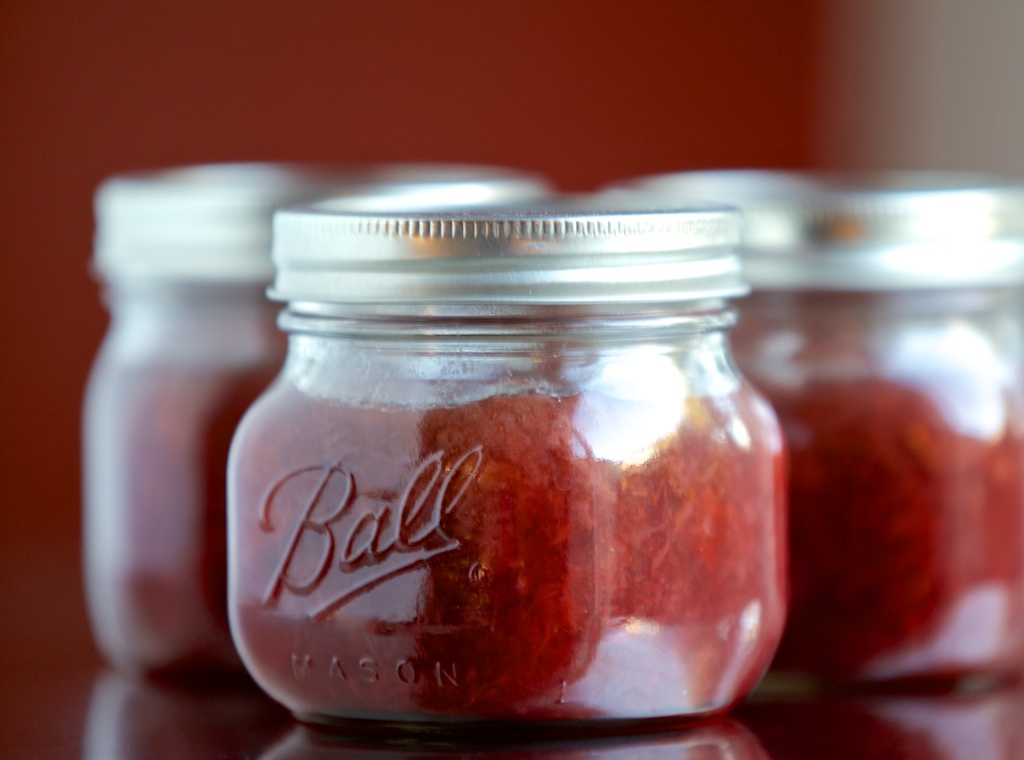
[B]ack in the day, which is really only an arm-length back, a generation or two, ladies “put up” vegetables and fruits in an ongoing summertime ritual as the produce came to fruition in their gardens and orchards. By fall, cellar shelves were agleam with shining jars of jewel colors, the “fruit” of their efforts. It was as common a practice then as hanging clothes out on the line or gathering eggs.
Fast-forward and it’s becoming practice again, not by necessity, but by choice. We want to take back control of what we eat, and we want what we eat to be good. Nothing wrong with that. But we are out of practice, and some of us have big shoes (and jars) to fill.
As were her skills with bread-baking and other wizardry of kitchen, farm and field, I came from a parent who was a champion canner. Each summer, she made all manner of jams and jellies (some jellies from fruits seeming “unjellifiable”) and canned everything from tomatoes to green beens. She made her own pickles, ketchup, chili sauce. She belabored fearlessly in her own sweat and a cloud of steam from the boiling canner cauldron and ended up with jars full of treasure, each sealing and sending up a celebratory (and safe) “pop.”
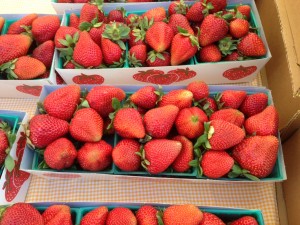 We are all just watered-down versions of those who came before, some of us more diluted than others. My mother continues to toil away in rural hood in a days-gone-by lifestyle that would appall the delicate damsels of our current pampered age. Like many of them, I became citified and strayed from my roots. She has a green thumb. My plants perch precariously between life and death and tend to do better when I leave them alone. I’m nowhere near her strength or skill, but I have attempted, somewhat minimally, to follow my mother’s legacy of the kitchen. What I hoped for was to make a jam that would stand up to her own.
We are all just watered-down versions of those who came before, some of us more diluted than others. My mother continues to toil away in rural hood in a days-gone-by lifestyle that would appall the delicate damsels of our current pampered age. Like many of them, I became citified and strayed from my roots. She has a green thumb. My plants perch precariously between life and death and tend to do better when I leave them alone. I’m nowhere near her strength or skill, but I have attempted, somewhat minimally, to follow my mother’s legacy of the kitchen. What I hoped for was to make a jam that would stand up to her own.
The strawberries I selected for my May foray into jam-making did not come from my own patch, but from the local fame’s market where, upon sampling, it was discovered that they were fully ripe, juicy and sweet.
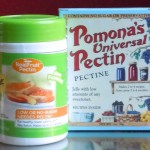 I was nervous about making jam. I had limited experience of my own (beyond helping/watching my mother throughout my youth…I was assigned the lengthly stirring of the apple butter), but a few years back had some success making a dried apricot jam (under my mother’s initial tutorial) that was not only beautiful and delicious, but also not dependent on seasonal ripe fruit.
I was nervous about making jam. I had limited experience of my own (beyond helping/watching my mother throughout my youth…I was assigned the lengthly stirring of the apple butter), but a few years back had some success making a dried apricot jam (under my mother’s initial tutorial) that was not only beautiful and delicious, but also not dependent on seasonal ripe fruit.
For my strawberry jam, I was determined to do things right, in not only making it tasty with the proper texture, but also making it lower sugar. If you read jam recipes, you’ll note there is usually an extraordinary amount of sugar involved, in part to make sure the jam firms up properly as it works with the pectin. But if the fruit is sweet enough, excessive sugar is unnecessary, particularly with the help of low- or no-sugar pectins.
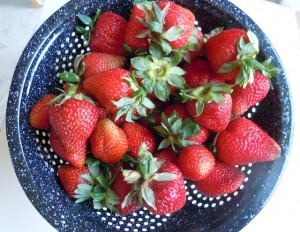 I went full force with my canning project, purchasing squatty pint jars and a canner with canning implements, including a magnet device used to lift sterilized lids from hot water. I did the complete sterilization of jars and lids, and while they took their bath in simmering water, I got my fresh berries ready, first slicing them up, then smashing them with a potato masher. This deconstructing of the berry was decidedly satisfying and therapeutic. The berries, crushed and bleeding, gave up their sweet aroma…it smelled like jam already.
I went full force with my canning project, purchasing squatty pint jars and a canner with canning implements, including a magnet device used to lift sterilized lids from hot water. I did the complete sterilization of jars and lids, and while they took their bath in simmering water, I got my fresh berries ready, first slicing them up, then smashing them with a potato masher. This deconstructing of the berry was decidedly satisfying and therapeutic. The berries, crushed and bleeding, gave up their sweet aroma…it smelled like jam already.
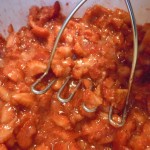 I sprinkled over and mixed in the low-sugar pectin and let that sit for a bit. Here, I readied my own twists on my jam. Why not personalize it…that’s what cooking can be! Since I usually prepared fresh strawberries with three added ingredients — orange zest, orange juice and a tiny bit of honey, I decided I would incorporate these into the jam as well. The orange really enhances and supports — but does not overwhelm — the berries. The honey adds richness and a flavorful nectar. How could this go wrong in jam? I would still have sugar in my jam, but following the proportions of the low-sugar recipe from the pectin label, I would be using much less. The full-sugar recipes I looked at from various resources on average used about 5 to 7 cups of sugar for 4 to 6 pints of jam. With my jam, I would be using more like 2 to 2-1/2, a significant reduction.
I sprinkled over and mixed in the low-sugar pectin and let that sit for a bit. Here, I readied my own twists on my jam. Why not personalize it…that’s what cooking can be! Since I usually prepared fresh strawberries with three added ingredients — orange zest, orange juice and a tiny bit of honey, I decided I would incorporate these into the jam as well. The orange really enhances and supports — but does not overwhelm — the berries. The honey adds richness and a flavorful nectar. How could this go wrong in jam? I would still have sugar in my jam, but following the proportions of the low-sugar recipe from the pectin label, I would be using much less. The full-sugar recipes I looked at from various resources on average used about 5 to 7 cups of sugar for 4 to 6 pints of jam. With my jam, I would be using more like 2 to 2-1/2, a significant reduction.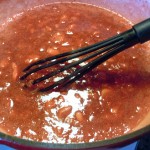
My most unique ingredient was a happy accident. The recipe recommended some fruit juice for the jam concoction. Looking at what I had on hand, I discovered an organic, no-sugar added pomegranate juice i had bought for something else. Ho! That just might be too delicious…
Once all was combined, the jam cooked. I stirred diligently. A fruity steam filled the kitchen and made the indoor climate sweetly semi-tropical. Skimming the mounting pink foam off the jam and putting said foam in a bowl (to be taste-tested later) took me back to my observations of jam-making as a youth. I delicately lifted jars and lids (the magnet was handy) out of their bath and got all ready for filling.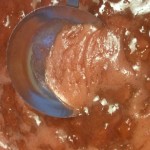
I ladled each jar to just under the neckline with the to fruit mash. The jam was thick and chunky, ruby red. Using all my strength, I tightened each jar lid, then submerged all once again in the just-under-boiling water.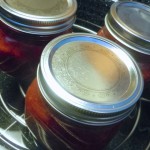
After about 10 minutes in their bath, the jars were removed and dried with a towel. I waited, ears poised as if listening for an echoing call from across a far-off field. Over the course of an hour and a half or so, I heard the successful sounds of my efforts, cheerful “pops” indicating a seal!
I made strawberry jam on two successive Saturday afternoons. I enjoyed every minute of it and every effort it entailed. I have jewel-filled jars, some of which I’ve beribboned and given away. And I’ve tasted myself…the full juicy strawberry flavor, the hint of bright orange like sunshine and that under note of deep red pomegranate. My toast has not been this happy in awhile. “I’ll be sending a jar home.”
I continue to be surprised and delighted when things turn out. It is a wonder at times. Expect nothing and you will yield much! As the summer moves along, fruits will come and go in their seasons, but I hope to capture some of their ripeness and keep it a little while longer. I’ll jam again. 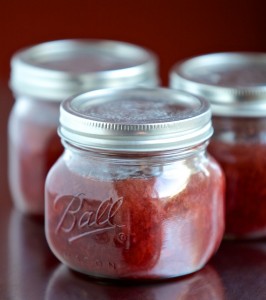
Fresh Strawberry Jam (Low-Sugar)
Makes 4 to 5 pint jars of jam
4 to 5 pint baskets of ripe strawberries
Zest of 1 orange
Juice of 1 orange
1/2 cup no-sugar added pomegranate juice3 tablespoons low-sugar pectin (Ball)
2 to 2-1/2 cups sugar
1.4 cup honey
Place flat lids, sealing rings and jars in a large kettle or canning pot full of water. Bring to a simmering boil. Keep water on simmer until time to fill jars.
Cut up strawberries and place them in a large heavy pot or Dutch oven. Mash to desired consistency with a potato masher. Add orange zest, orange juice and pomegranate juice. Sprinkle over and stir in pectin. Allow to sit for about 10 minutes.
Over high heat, bring strawberry mixture to a boil. Stir in sugar and honey. Continue stirring until it reaches a boil. Boil for 1 minute, stirring constantly. Remove from heat and skim off foam that has collected at the top of the jam (you can save this for a “cook’s treat”) later).
Remove lids and jars from hot water, dry thoroughly. Using a funnel, ladle jam into jars, filling up to about 1/2 inch below neck of jar. Once all jars are filled, use a damp paper towel to clean jar rims. Gently center and press flat jar lids on each jar, then seal tightly with rings. Carefully lower jars into hot water in canner (on rack if using). Water should cover jars completely, at least by an inch. Place canner lid on top of pot; steep jars of jam in water for about 10 minutes.
Remove jars from hot water and set in a safe place, undisturbed. Lids should “pop” when jam is sealed, but one can tell if their is a seal by pressing jar lid. It should be firm and not flex up or down.